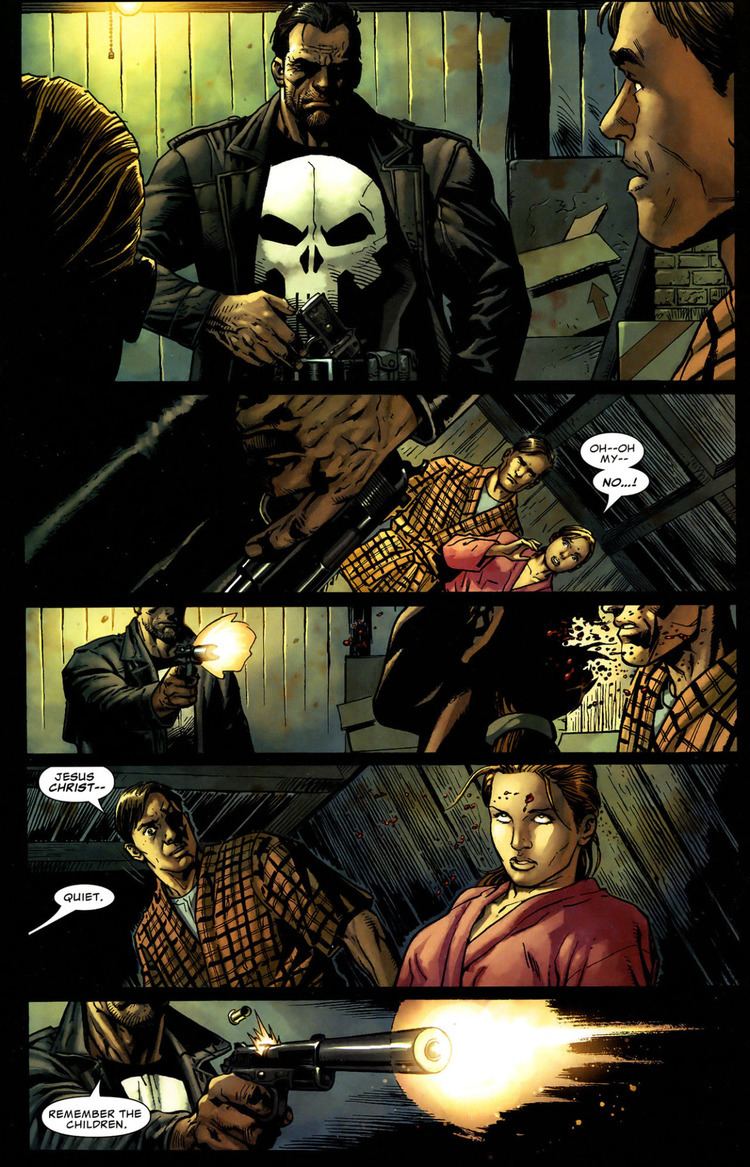Schedule Monthly Number of issues 751 annual (2007) | ||
 | ||
Publication date March 2004 – October 2009 Similar Punisher Max, Punisher Kills the Marvel U, The Punisher War Jour, Born, Punisher | ||
The Punisher (titled The Punisher: Frank Castle after issue #66, sometimes referred to as The Punisher MAX) was a comic book ongoing series published under the MAX imprint of Marvel Comics, featuring vigilante anti-hero, the Punisher.
Contents
Publication history
Garth Ennis, also writer of the 2000 and 2001 Punisher series, wrote issues #1-60 of the series. Also like the earlier series, Tim Bradstreet provided the covers for those issues. Continuing his run on the character, Ennis used the freedom of the MAX imprint to write more graphic and hard-edged stories than had previously been seen. Ennis also wrote two miniseries accompanying the main series, The Punisher Presents: Barracuda and The Punisher: Born. Several one-shots were also produced, some written by Ennis and some by other writers.
With issue #61, Gregg Hurwitz replaced Ennis as writer joining artist Laurence Campbell to do a five-issue story arc. With issue #66 released on January 21, 2009, the series was retitled Punisher: Frank Castle, with writer Duane Swierczynski and artist Michel Lacombe coming to the series. Victor Gischler came on board for the storyline "Welcome to the Bayou" in issues #71-74 before the title finished with issue #75, a double-length issue with stories by Thomas Piccirilli, Gregg Hurwitz, Duane Swierczynski, Peter Milligan, and Charlie Huston.
The title was relaunched as PunisherMAX in late 2009, with writer Jason Aaron and artist Steve Dillon.
Differences with mainstream Punisher
The series explicitly does not use a floating timeline like the Marvel Universe, instead presenting a Punisher who ages in real time. Gravestones and other references indicate that his family was killed in 1976. The Punisher has been active for almost 30 years at the time presented in most stories, with issue #19 specifying that he has killed approximately 2,000 people. The Punisher: Born also establishes that the Punisher's service in the Vietnam War is still in MAX continuity.
Promotional art for the cover of Punisher vol. 7, #44 (March 2007), gives Frank Castle's birth date as February 16, 1950, but that was removed for the published issues. The story Valley Forge, Valley Forge corroborates this date, referring to Castle as "a twenty one year old Captain" in April 1971.
Another major difference is the complete lack of superheroes and supervillains in the series, although non-superpowered characters from the Punisher's past, most notably Microchip, do make appearances. Nick Fury also makes several notable appearances, with his characterization echoing Ennis's MAX-imprint Fury stories. However, the character Jen Cooke, a social worker, appeared in the Marvel Knights storyline "Hidden". She then appeared in the MAX storyline "Slavers". The character Yorkie Mitchell made appearances in both the Marvel Knights and the MAX Punisher comics.
In the Civil War Files comic, just before the "Civil War" storyline was published, Iron Man talked about events in the Punisher's past from the Marvel Knights and MAX comic:
The MAX Punisher often focus on current events, ranging from corporate fraud to sexual slavery, and the War on Terror. Many characters are past or current intelligence and military operatives from governmental agencies like the CIA, KGB, Secret Intelligence Service, SAS, militaries and militias from the Balkans and Middle East, also including the IRA, all with agendas rooted in past conflicts like the Cold War or the Yugoslav wars.
